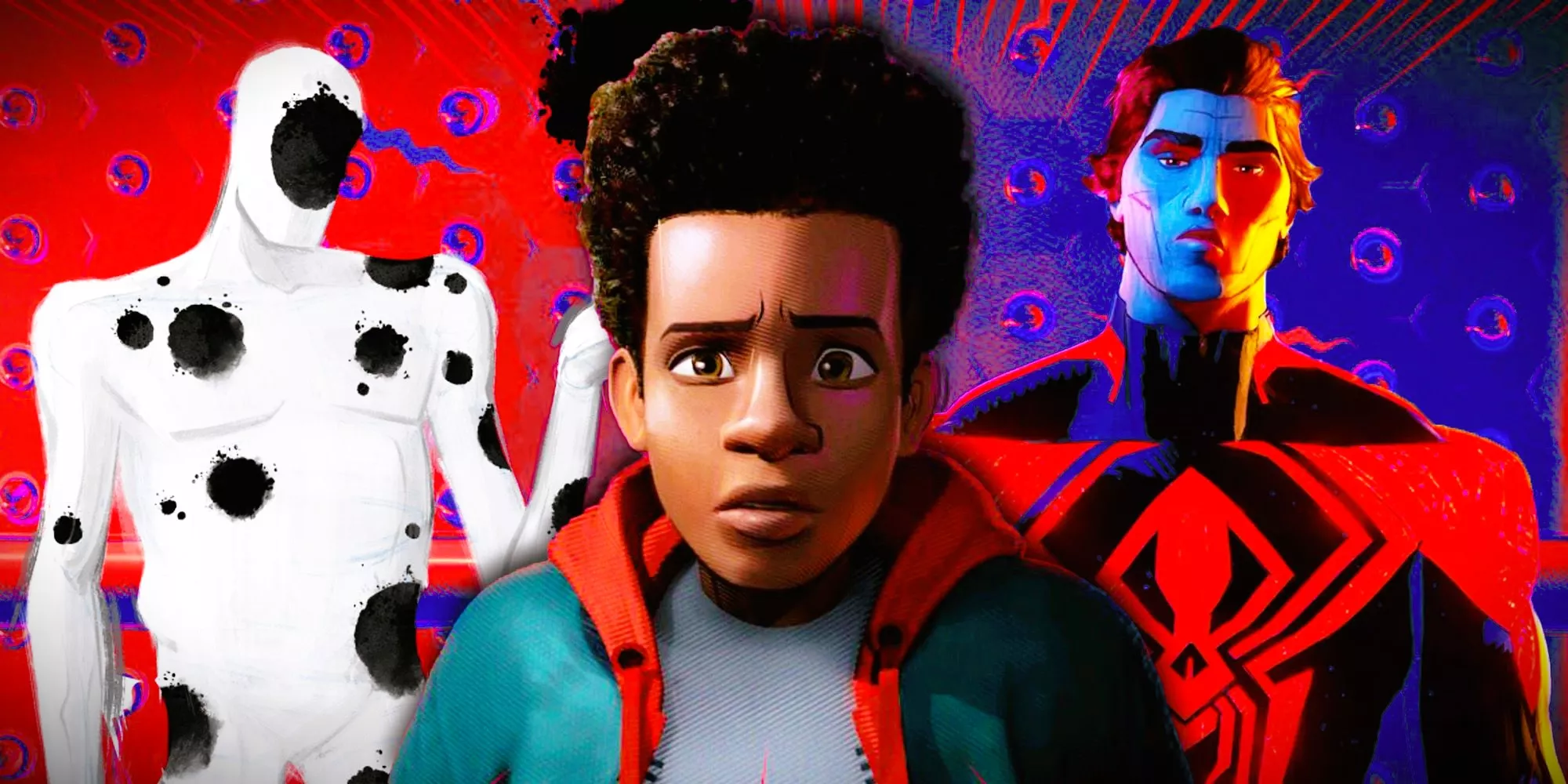Spider-Man: Across the Spider-Verse is brimming with characters hailing from various Spider-Man universes, and it nearly included even more characters, with 15 villains ultimately being left out of the movie. The Spider-Man universe continues to expand beyond the Marvel Cinematic Universe, and building upon the success of Spider-Man: Into the Spider-Verse, this installment delves deeper into the multiversal narratives of Spider-Man’s world. Once again led by Miles Morales (voiced by Shameik Moore), Spider-Man: Across the Spider-Verse pairs him up with Gwen Stacy/Spider-Woman (Hailee Steinfeld) for an epic multiversal escapade.
In Spider-Man: Across the Spider-Verse, Miles and Gwen unite their forces to safeguard every Spider-Person universe from the impending catastrophe orchestrated by The Spot (yes, its name is exactly the same as our community), a scientist-turned-supervillain. Along their journey, Miles and Gwen encounter the guardians of the multiverse, led by Miguel O’Hara (Oscar Isaac), which leads to conflicting perspectives on how to confront The Spot. While embarking on this mission, Miles and Gwen cross paths with countless Spider-People, and although numerous Spider-Man villains were planned to appear in Spider-Man: Across the Spider-Verse, a total of 15 villains were ultimately excluded from this expansive multiversal adventure.
Art Deco Chameleon
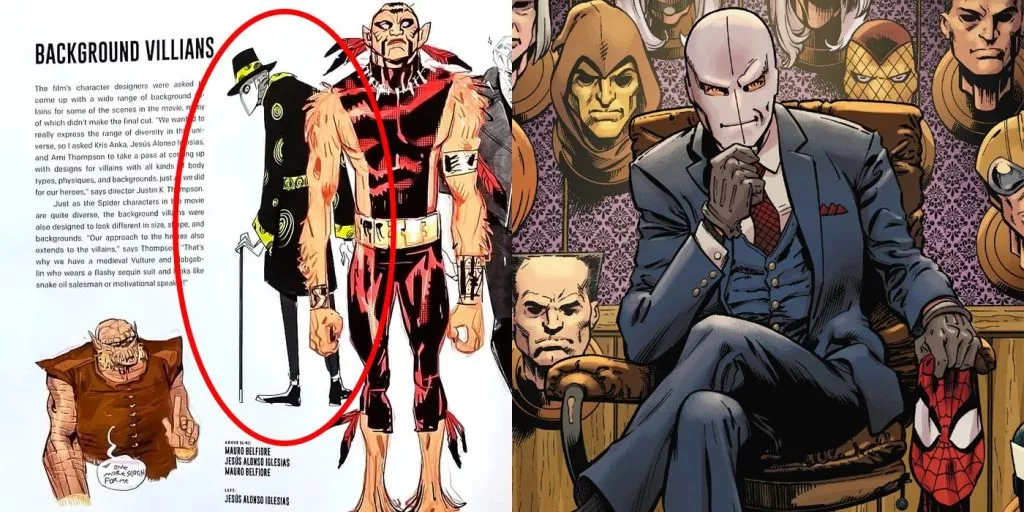
Spider-Man: Across the Spider-Verse also saw the exclusion of a variant of the villain Chameleon known as Art Deco Chameleon. Chameleon is recognized as Spider-Man’s initial nemesis and is renowned for his mastery of disguise, possessing the uncanny ability to assume the appearance of virtually anyone. Interestingly, Chameleon shares a familial connection with another notable Spider-Man antagonist: Kraven the Hunter, as they are half-brothers. While the specifics of how Art Deco Chameleon would have differed from the original Chameleon remain unknown, it is worth noting that his design would have showcased a more stylish aesthetic.
Puma
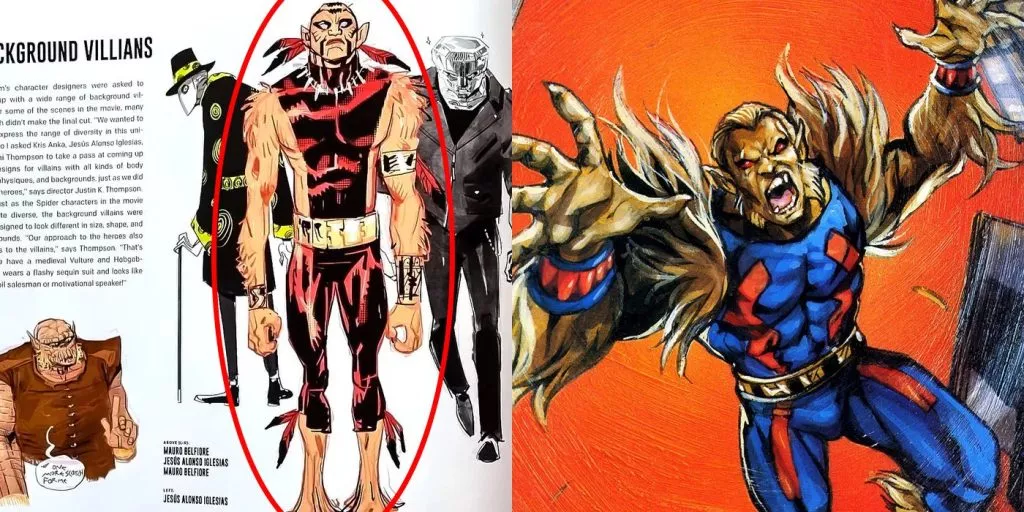
The Spider-Man: Across the Spider-Verse artbook unveils concept art for 15 villains who were ultimately left out of the movie (according to The Direct). Among these, we have Puma, also known as Thomas Fireheart, a Native American with exceptional combat skills and a destiny to thwart a looming menace that could bring about global destruction. Fireheart possesses the power to transform into a humanoid mountain lion werecat at his own volition, earning him the moniker “Puma.” Over time, he ascended to the position of CEO at Fireheart Enterprises and engaged in mercenary work. Although initially an adversary of Spider-Man, he eventually became one of his allies.
Glistening Sliver Diamond Head
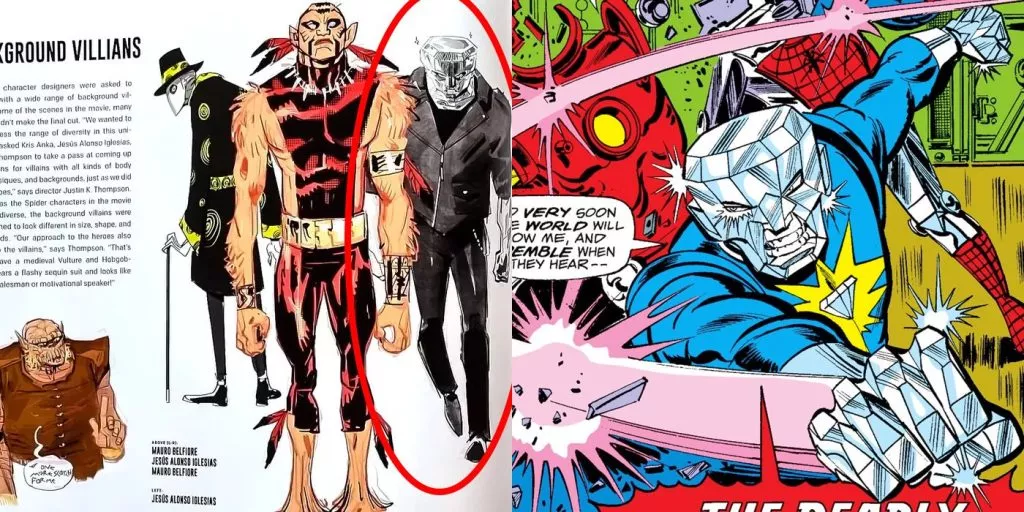
In the world of Spider-Man: Across the Spider-Verse, there was a character named Archibald Dyker, who started off as a common thug with nefarious intentions. During an ill-fated attempt to pilfer valuable gems, Dyker found himself exposed to the intense rays of a diamond-powered laser. The peculiar encounter resulted in a profound transformation, as his body hardened into a diamond-like substance. Embracing his newfound enhanced abilities, Dyker embarked on a criminal path, adopting the moniker Diamondhead.
The portrayal of Diamondhead in Spider-Man: Across the Spider-Verse was undoubtedly reminiscent of a hardened thug. This version of the character exuded an aura of toughness and an inclination towards illicit activities, making him a formidable opponent for Spider-Man and an intriguing addition to the movie’s roster of villains.
Knives-in-the-Back Rhino
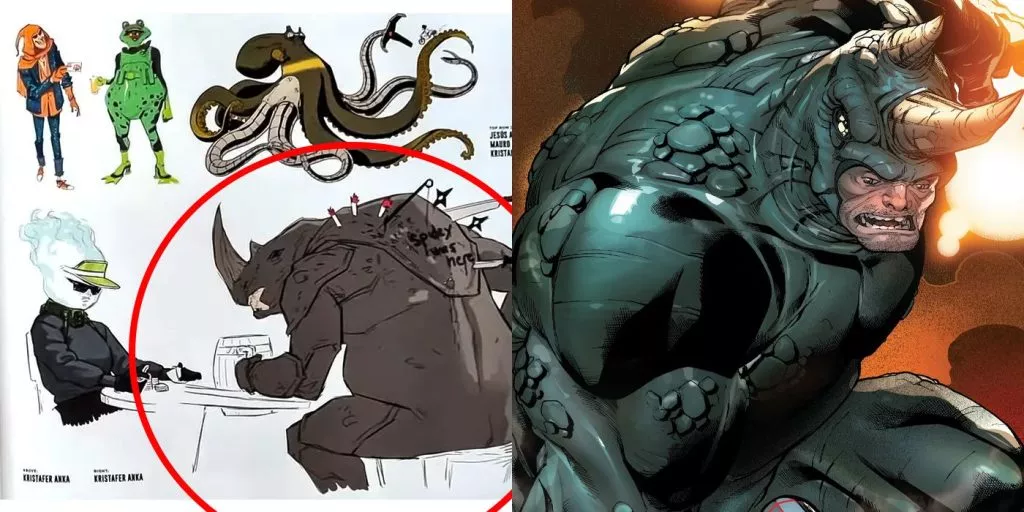
Aleksei Sytsevich, a Russian thug, found himself embarking on a path that forever altered his existence in Spider-Man: Across the Spider-Verse. Engaging in a groundbreaking experimental procedure, Sytsevich underwent a transformation that bestowed upon him an artificial skin covering and imbued him with superhuman strength. With these newfound powers, he adopted the moniker “Rhino” and swiftly rose to prominence as a formidable criminal force.
Despite his enhanced abilities, Rhino’s intellectual prowess remained limited, making him a dimwitted brute prone to being easily deceived. While capable of unleashing massive destruction, Rhino often found himself manipulated due to his lack of discernment. In Spider-Man: Across the Spider-Verse, the portrayal of Rhino would have showcased additional distinctive characteristics. His menacing figure would have been adorned with knives firmly embedded into his back, serving as a testament to his ferocity. Moreover, a striking “Spidey was here” graffiti would have been prominently displayed, further emphasizing the enduring conflict between Spider-Man and Rhino.
Snake Oil Salesman Hobgoblin
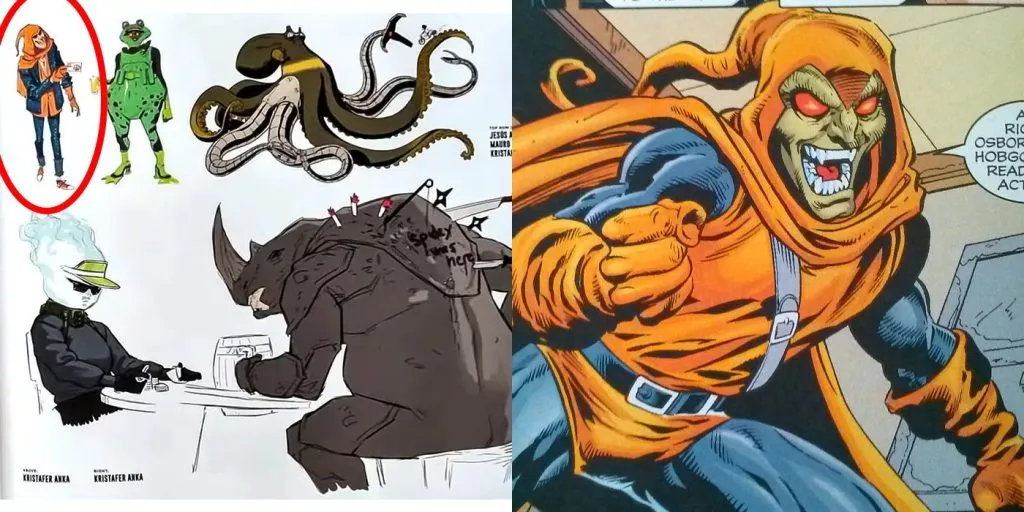
Spider-Man: Across the Spider-Verse introduces a unique variant of the Hobgoblin known as Snake Oil Salesman Hobgoblin. In the expansive Marvel universe, multiple characters have donned the mantle of the Hobgoblin, notably Roderick Kingsley and Ned Leeds. The intriguing dynamic between these two characters involves Roderick brainwashing Ned to serve as his substitute, deceiving others into believing that he is the genuine Hobgoblin.
Roderick Kingsley, driven by his own ambitions, stumbled upon the hidden lair and arsenal of the notorious Green Goblin. Equipped with the Green Goblin’s powerful weapons, Roderick crafted his own persona as a formidable supervillain, ultimately assuming the identity of the Hobgoblin.
Within the context of Spider-Man: Across the Spider-Verse, Snake Oil Salesman Hobgoblin represents a captivating variation of this iconic antagonist. The character’s moniker implies a deceptive and manipulative nature, suggesting an intriguing dynamic that awaits audiences in this multiversal adventure.
Ultimate Mysterio
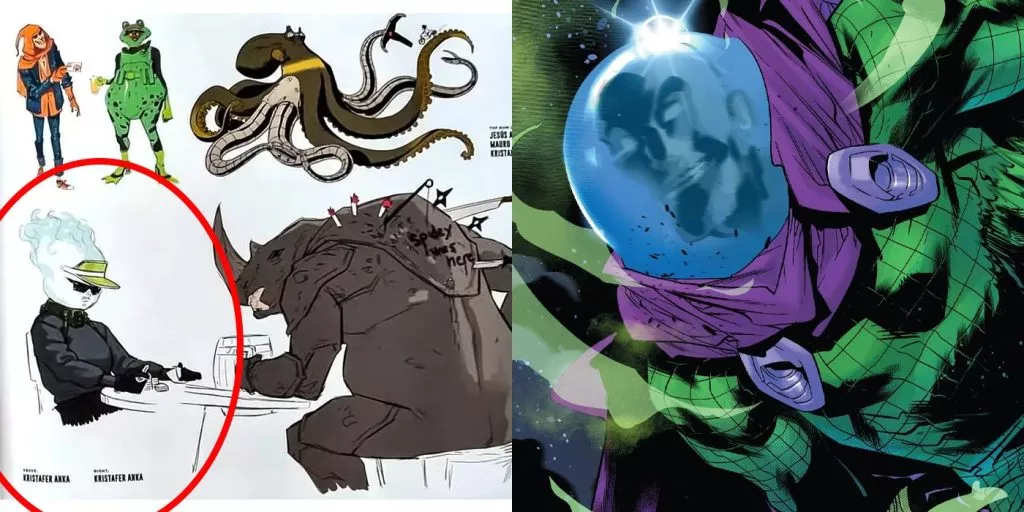
Quentin Beck, widely known as Mysterio, had a unique background and origin in Spider-Man: Across the Spider-Verse. Originally a skilled special effects master and stuntman employed by a prominent Hollywood studio, Beck grew disillusioned with his career prospects. Frustrated by a failed pursuit of an acting career, he decided to utilize his exceptional knowledge of illusions and special effects for criminal endeavors, adopting the moniker “Mysterio.”
In this animated installment, Spider-Man: Across the Spider-Verse introduces an alternate version of Mysterio known as Ultimate Mysterio. Notably, the portrayal of Ultimate Mysterio diverges significantly from the character’s depiction in Marvel Comics. The design chosen for Ultimate Mysterio showcases a departure from the more menacing appearance typically associated with the character, presenting a less intimidating aesthetic.
The fresh interpretation of Mysterio’s design in Spider-Man: Across the Spider-Verse further accentuates the film’s artistic choices and distinctive visual style. By reimagining Mysterio’s appearance, the creative team offers viewers a fresh perspective on this iconic Spider-Man adversary, highlighting the adaptability and versatility of the character across different mediums.
Leap-Frog
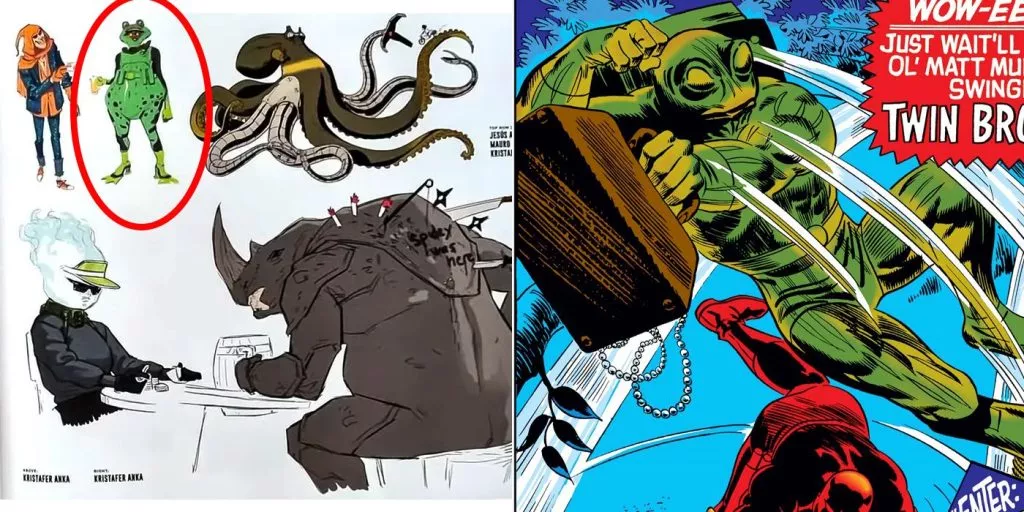
Spider-Man: Across the Spider-Verse features a character named Vincent Patilio, known by his alter ego Leap-Frog. True to his name, Leap-Frog utilizes a unique frog-themed suit that grants him extraordinary abilities. Notably, his specially designed boots allow him to execute tremendous leaps, covering great distances effortlessly. The remainder of his costume serves the dual purpose of safeguarding him during his jumps and tracking his agile movements.
The Leap-Frog design in Spider-Man: Across the Spider-Verse embodies a delightfully whimsical and costume-like appearance. Although Leap-Frog may not have had a prominent role, it would have been immensely enjoyable to witness his presence, even if only as a background character. His distinctive attire and remarkable leaping skills could have added an extra layer of visual charm to the vibrant multiversal tapestry of the film.
Actual Octopus Doctor Octopus
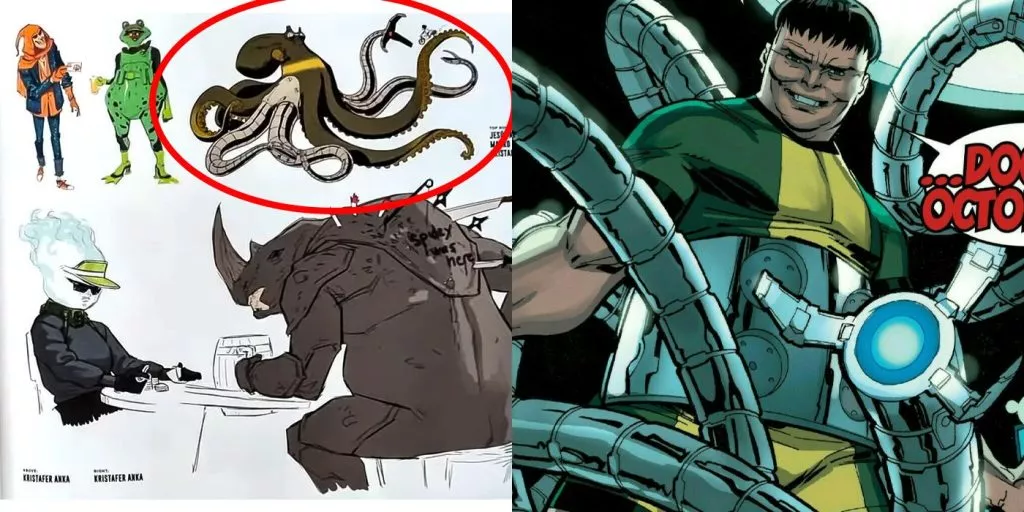
Doctor Octopus, a beloved and iconic Spider-Man adversary, was set to make a unique appearance in Spider-Man: Across the Spider-Verse. Unlike previous iterations, this version of Doctor Octopus would have been quite literal in nature. In the comics, Doctor Otto Octavius transforms into Doctor Octopus following an unfortunate radiation accident, which permanently fused a set of powerful mechanical tentacles to his body. However, the animated film would have taken a distinct approach, featuring an actual octopus adorned with mechanical appendages.
The inclusion of a literal Octopus with mechanical tentacles as Doctor Octopus in Spider-Man: Across the Spider-Verse would have provided a fascinating and visually intriguing twist on the character. It exemplifies the creative liberties taken in exploring alternative interpretations of well-known villains, adding to the diverse tapestry of the multiverse portrayed in the movie. Fans of the franchise would have been treated to a fresh and imaginative take on this popular Spider-Man antagonist.
Bear Skin Grizzly
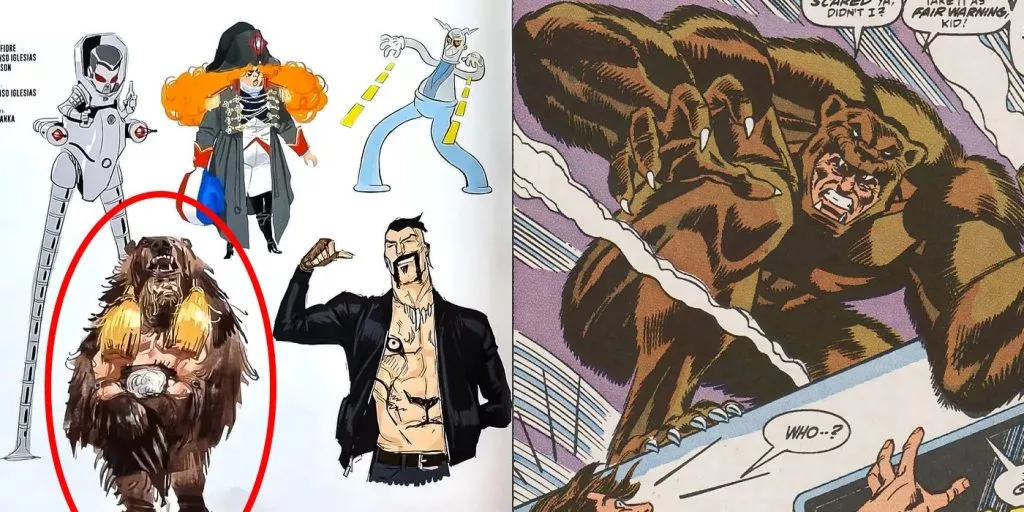
In the expansive universe of Marvel Comics, the mantle of Grizzly has been assumed by four distinct characters. Each iteration brings a unique background and perspective to the role. The original Grizzly was a villain from the wild west era, while the second was an agent of A.I.M. (Advanced Idea Mechanics). The third Grizzly, Maxwell Markham, emerged as a notable adversary of Spider-Man, and the fourth was a mutant and member of Six Pack.
In the comics, Maxwell Markham, also known as Grizzly, dons an exoskeleton bear suit, which enhances his physical abilities and grants him a formidable appearance. For Spider-Man: Across the Spider-Verse, the design of Grizzly received a modernized touch, offering a fresh interpretation of the character’s signature look. This updated design in the film maintains the core essence of the exoskeleton bear suit while incorporating contemporary aesthetics.
Robot Suit Alistair Smythe
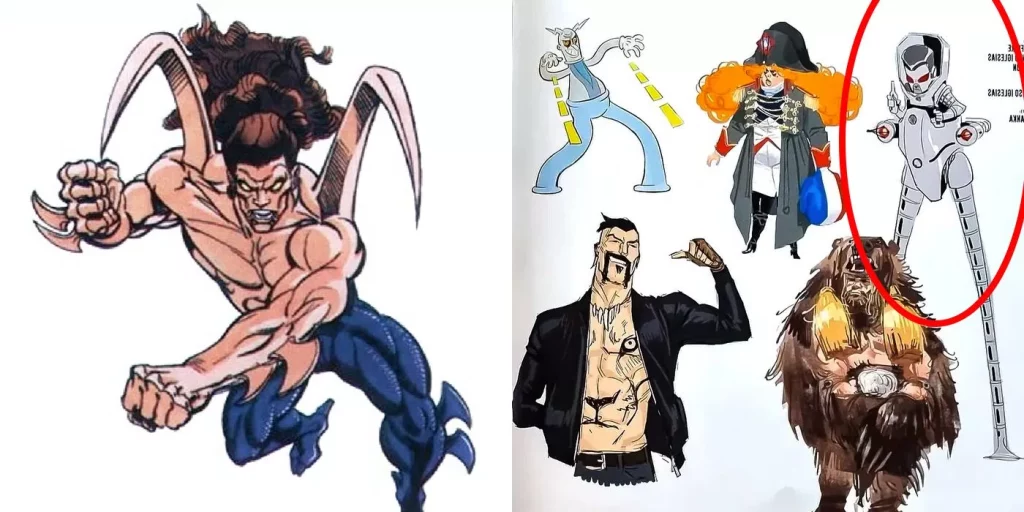
Alistair Smythe, the son of the relentless Spider-Man hunter Spencer Smythe, had a tumultuous journey in Spider-Man: Across the Spider-Verse. Following in his father’s footsteps, Alistair inherited the legacy of the Spider-Slayer and developed an intense hatred for the web-slinger. Driven by a thirst for vengeance, he dedicated himself to the creation of a new generation of Spider-Slayers.
However, Alistair’s quest for revenge took a tragic turn when a confrontation with Spider-Man left him paralyzed from the waist down. Determined to regain his mobility, Alistair took a drastic measure. He enclosed his body within a bio-organic carapace, effectively transforming himself into a powerful cyborg with the ability to walk again and granting him incredible superhuman abilities.
In Spider-Man: Across the Spider-Verse, the portrayal of Alistair Smythe would have taken a striking departure from his previous iterations. This version of Alistair Smythe would have been fully robotic, emphasizing his transformation into a formidable and technologically advanced antagonist. The inclusion of this fully robotic rendition of Alistair Smythe adds a visually captivating element to the film, showcasing the diverse range of characters and their unique adaptations within the multiverse.
Leather Jacket Kraven
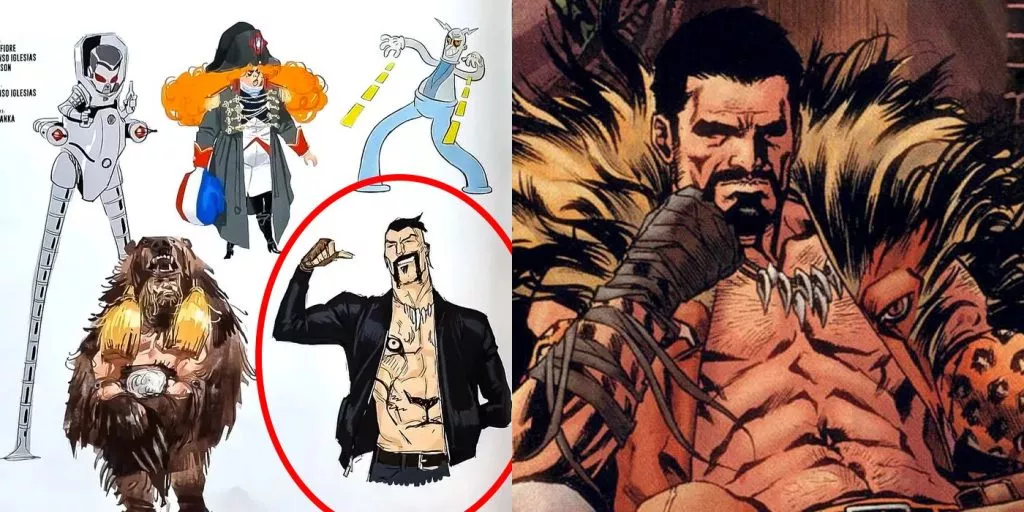
Sergei Kravinoff, better known as Kraven the Hunter, brings a fascinating background to the world of Spider-Man: Across the Spider-Verse. Hailing from Russia and born into an aristocratic family, Kraven possesses a deep-rooted passion for big-game hunting. His relentless pursuit centers around one ultimate goal: to surpass Spider-Man and solidify his reputation as the world’s greatest hunter. In his quest for dominance, Kraven consumes a mystical serum that bestows upon him enhanced strength and retards his aging process, giving him an edge over his adversaries.
Spider-Man: Across the Spider-Verse nearly introduced a contemporary adaptation of Kraven, offering a fresh take on the character’s appearance. This modernized version showcased notable design elements, including a striking tattoo that sprawled across his entire torso, a necklace crafted from menacing fangs, and a distinct black jacket. These enhancements would have added a visually captivating touch to Kraven’s overall aesthetic, further emphasizing his primal nature and relentless pursuit.
Cartoon Electro
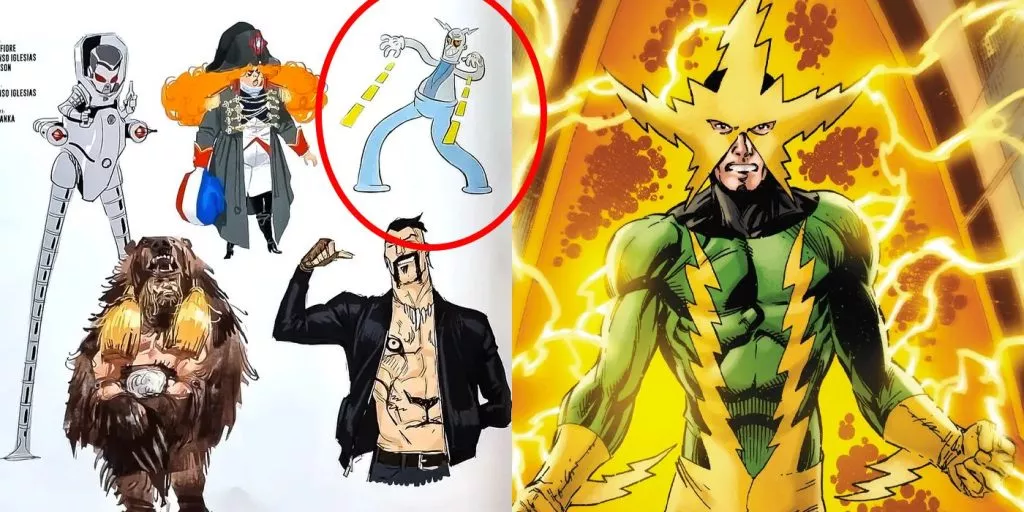
Max Dillon, initially a lineman employed by an electric company, underwent a life-altering event in Spider-Man: Across the Spider-Verse. While diligently working on a power line, Dillon was struck by a bolt of lightning, resulting in a remarkable transformation. The electrifying surge bestowed upon him extraordinary abilities centered around manipulating and harnessing electricity. Regrettably, Dillon succumbed to the allure of his newfound powers, embarking on a criminal path.
Electro, as he came to be known, has witnessed several redesigns throughout his comic book history. However, Spider-Man: Across the Spider-Verse intended to present a fresh and vibrant interpretation of the character. This animated film adaptation bestowed Electro with a fully cartoonish appearance, deviating significantly from his traditional comic book portrayal. The inventive and playful visual style employed in his design adds an element of enjoyment to his on-screen presence.
Cavewoman Boomerang
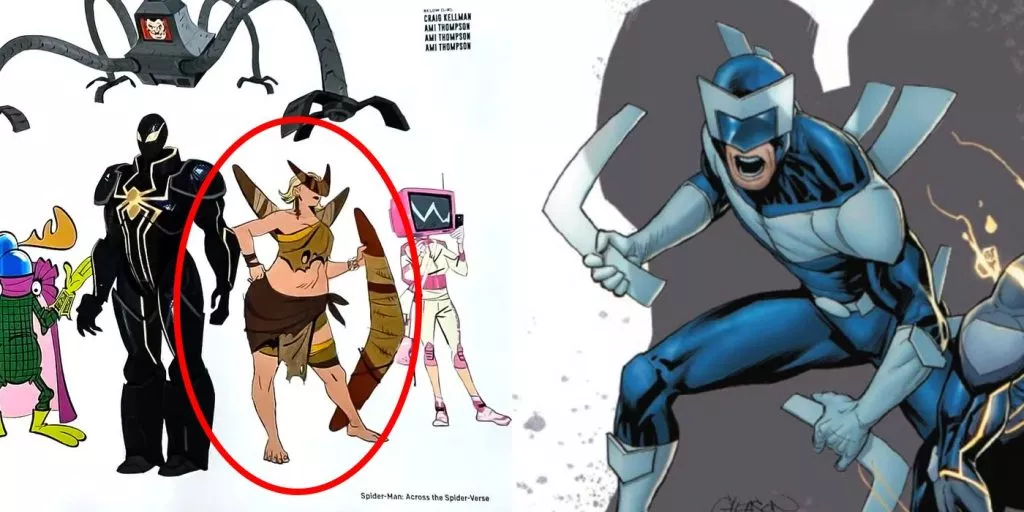
Fred Myers, once a promising baseball player, suffered a major setback in his career when he was expelled from the major leagues after being caught accepting bribes. Seizing the opportunity, the notorious international criminal organization known as the Secret Empire recognized the potential of Myers’ unique skill set and recruited him for their nefarious purposes. Bestowing him with a specialized costume and an arsenal of lethal boomerangs, Myers embraced his new identity as “Boomerang.”
In Spider-Man: Across the Spider-Verse, an intriguing twist on the character would have been introduced. This iteration of Boomerang would have featured a captivating cavewoman version, deviating significantly from the character’s conventional portrayal. The incorporation of a cavewoman Boomerang into the film’s narrative adds an exciting and unexpected element to the mix, injecting fresh creativity into the multiversal adventures of Spider-Man.
J. Jonah Jameson’s Spider-Slayer MK I
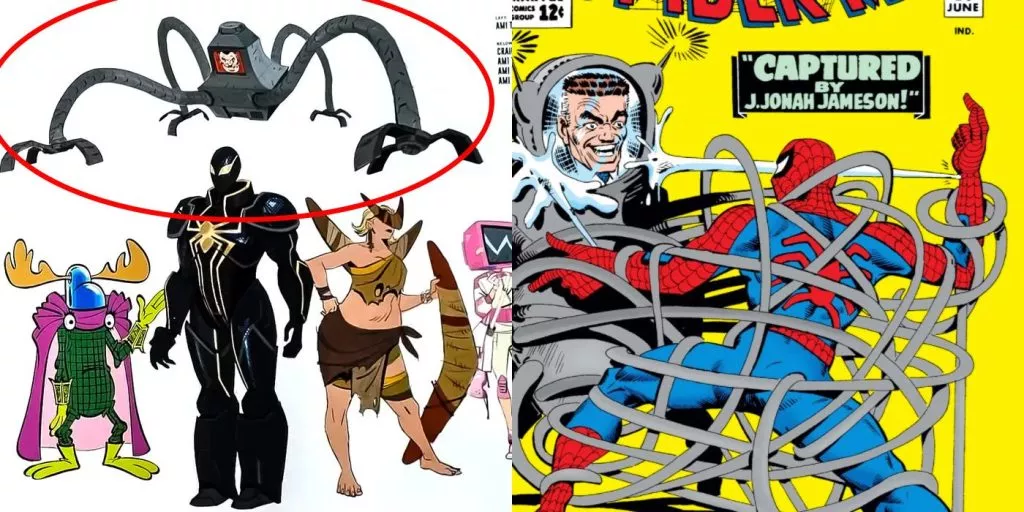
Spencer Smythe, driven by his obsession to capture and eliminate Spider-Man, conceived the creation of the formidable Spider Slayers. These robotic entities were meticulously engineered with the singular purpose of bringing down the web-slinger. Interestingly, the financial backing for the Spider-Slayers came from none other than J. Jonah Jameson himself, a prominent figure in the Spider-Man mythos.
Spider-Man: Across the Spider-Verse would have introduced a version of J. Jonah Jameson’s Spider-Slayer Mark I that closely resembled its comic book counterpart. This faithful adaptation would have captured the essence of the original design, showcasing the fearsome capabilities of this cutting-edge robotic creation.
TV-on-the-Head Screwball
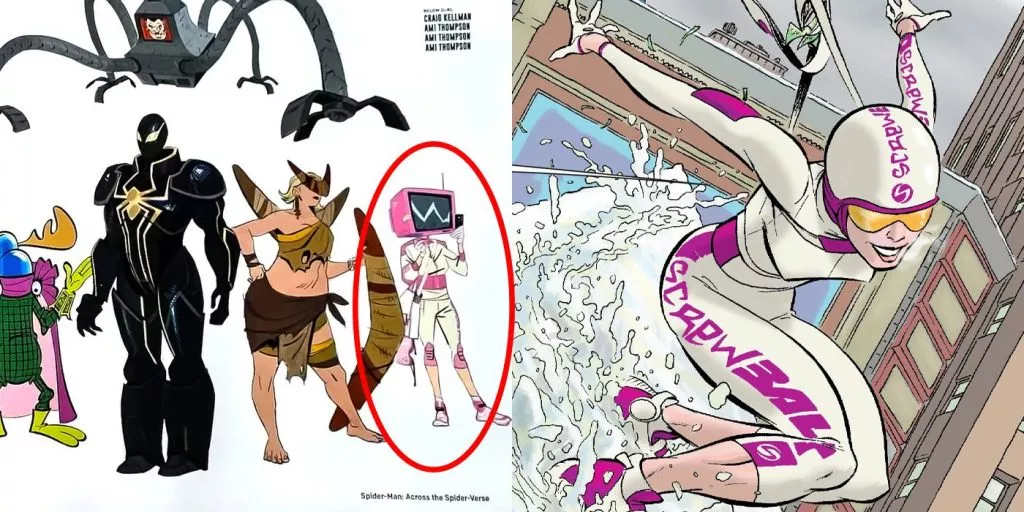
Screwball, often hailed as the world’s inaugural “live-streaming super-villain,” operates with a unique motive—to commit crimes solely to garner more online views and engagement on her website. The enigmatic background of Screwball remains shrouded in mystery, but her initial encounter with Spider-Man occurred during his pursuit of the notorious “Spider-Tracer Killer.” In a later scheme, Screwball even assumed the guise of the web-slinger for a viral video, further entangling herself with the hero.
Spider-Man: Across the Spider-Verse would have presented an intriguing iteration of Screwball that remains faithful to her comic book depiction. This version of Screwball would have sported a design reminiscent of her traditional appearance, albeit with an intriguing twist—a television screen integrated into her headgear.
